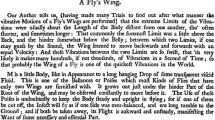Abstract
The significance of the histological changes induced by filarial larvae in the indirect flight muscle fibres of susceptible female mosquitoes was investigated by inflicting mechanical (needle-puncture) injury on thoracic tissues of male and female mosquitoes of various species. Mechanical injury caused the flight muscle of all mosquitoes, irrespective of species, sex or filarial susceptibility, to react in the same way as that of filaria-infected, susceptible females; other thoracic tissues responded in a similar fashion. Since these responses are closely akin to those observed by earlier authors in various tissues of other insects subjected to experimental trauma, it seems reasonable to regard the reactions of indirect flight muscle of mosquitoes to filarial larvae as an example of a common, non-specific response by insects to a range of traumatic stimuli.
Similar content being viewed by others
References
Barth RH, Bunyard PP, Hamilton TH (1964) RNA metabolism in pupae of the oak silkworm,Antheraea pernyi: the effects of diapause, development, and injury. Proc Natl Acad Sci USA 52:1572–1580
Beckett EB (1971) Histological changes in mosquito flight muscle fibres associated with parasitization by filarial larvae. Parasitology 63:365–372
Berry SJ, Krishnakumaran A, Oberlander H, Schneiderman HA (1967) Effects of hormones and injury on RNA synthesis in saturniid moths. J Insect Physiol 13:1511–1537
Bosworth W, Sullivan JJ, Chernin E (1976) Infective larvae ofBrugia: escape from mosquitoes into water and subsequent infectivity in jirds. Am J Trop Med Hyg 25:700–703
Brady J (1965) A simple technique for making very fine, durable dissecting needles by sharpening tungsten wire electrolytically. Bull WHO 32:143–144
Crossley AC (1975) The cytophysiology of insect blood. Adv Insect Physiol 11:117–221
Day MF, Bennetts MJ (1953) Healing of gut wounds in the mosquitoAedes aegypti (L.) and the leaf-hopperOrosius argentus (Ev.). Aust J Biol Sci 6:580–585
Desowitz RS, Chellapah WT (1965) Fate of transplanted third-stageBrugia pahangi larvae in normally susceptible and non-susceptible mosquito hosts. J Parasitol 51:195–199
Hockmeyer WT, Schiefer BA, Redington BC, Eldridge BF (1975)Brugia pahangi: effects upon flight capability ofAedes aegypti. Exp Parasitol 38:1–5
Kan S-P, Ho B-C (1973) Development ofBrugia pahangi in the flight muscles ofAedes togoi. Ultrastructural changes in the infected muscle fibers and the infecting filarial larvae. Am J Trop Med Hyg 22:179–188
Lai-Fook J (1968) The fine structure of wound repair in an insect (Rhodnius prolixus). J Morphol 124:37–78
Lehane MJ, Laurence BR (1977) Flight muscle ultrastructure of susceptible and refractory mosquitoes parasitized by larvalBrugia pahangi. Parasitology 74:87–92
Macdonald WW (1962) The selection of a strain ofAedes aegypti susceptible to infection with semi-periodicBrugia malayi. Ann Trop Med Parasitol 56:368–372
Newcomer EH (1953) A new cytological and histological fixing fluid. Science 118:161
Ramachandran CP, Zaini MA (1968) Studies on the transmission of subperiodicBrugia malayi byAedes (Finlaya)togoi in the laboratory: 1. The intake and migration of microfilariae. Med J Malaya 22:136–144
Ratcliffe NA, Rowley AF (1979) Role of haemocytes in defense against biological agents. In: Gupta AP (ed) Insect haemocytes. Development, forms, function and techniques. Cambridge University, Cambridge, pp 331–422
Skinner DM (1963) Incorporation of labelled valine into the proteins of the cecropia silk moth. Biol Bull 125:165–176
Spratt DM (1972) Natural occurrence, histopathology and developmental stages ofDirofilaria roemeri in the intermediate host. Int J Parasitol 2:201–208
Stevenson E, Wyatt GR (1962) The metabolism of silkmoth tissues: 1. Incorporation of leucine into protein. Arch Biochem Biophys 99:65–71
Wigglesworth VB (1937) Wound healing in an insect (Rhodnius prolixus: Hemiptera). J Exp Biol 14:364–381
Wigglesworth VB (1970) Insect hormones. Oliver & Boyd, Edinburgh (University review of biology 12)
Wyatt GR (1972) Insect hormones. In: Litwack G (ed), Biochemical actions of hormones, vol II. Academic, London New York, pp 385–490
Wyatt GR (1975) Hemolymph in insects and arachnids — some biochemical features. In: Maramorosch G, Shope RE (eds) Invertebrate immunity. Academic, New York, pp 225–240
Wyatt GR, Linzen B (1965) The metabolism of ribonucleic acid in cecropia silkmoth pupae in diapause, during development and after injury. Biochim Biophys Acta 103:588–600
Author information
Authors and Affiliations
Rights and permissions
About this article
Cite this article
Beckett, E.B. The non-specific nature of the response of mosquito flight muscle to filarial parasitization. Parasitol Res 76, 360–366 (1990). https://doi.org/10.1007/BF00928193
Accepted:
Issue Date:
DOI: https://doi.org/10.1007/BF00928193




